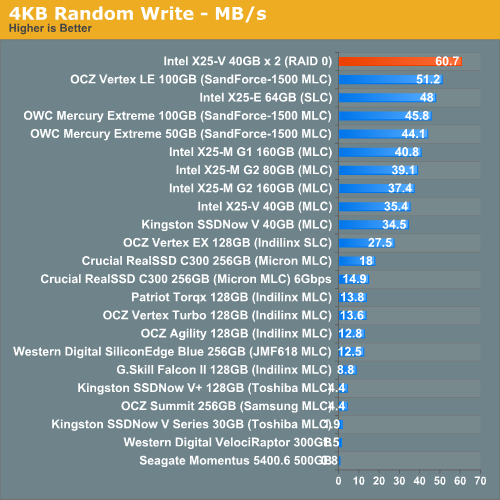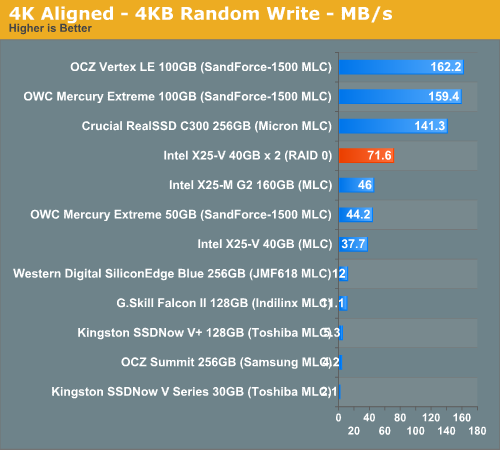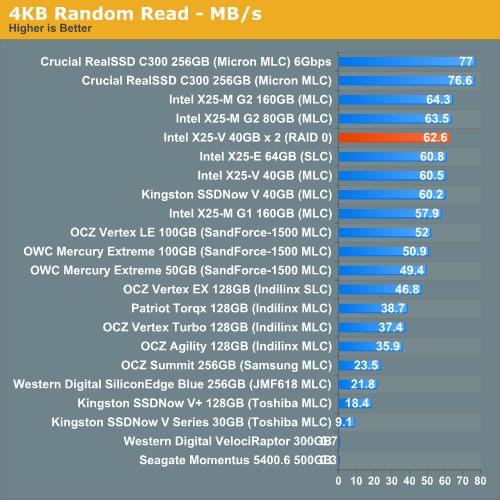Intel X25-V in RAID-0: Faster than X25-M G2 for $250?
by Anand Lal Shimpi on March 29, 2010 8:59 PM ESTRandom Read/Write Speed
This test reads/writes 4KB in a completely random pattern over an 8GB space of the drive to simulate the sort of random access that you'd see on an OS drive (even this is more stressful than a normal desktop user would see). I perform three concurrent IOs and run the test for 3 minutes. The results reported are in average MB/s over the entire time.
I've had to run this test two different ways thanks to the way the newer controllers handle write alignment. Without a manually aligned partition, Windows XP executes writes on sector aligned boundaries while most modern OSes write with 4K alignment. Some controllers take this into account when mapping LBAs to page addresses, which generates additional overhead but makes for relatively similar performance regardless of OS/partition alignment. Other controllers skip the management overhead and just perform worse under Windows XP without partition alignment as file system writes are not automatically aligned with the SSD's internal pages.
First up is my traditional 4KB random write test, each write here is aligned to 512-byte sectors, similar to how Windows XP might write data to a drive:

In sector-aligned 4K random writes, nothing is faster than our X25-V RAID 0 array. We're talking faster than Intel's X25-E, faster than SandForce...you get the picture.
Our 4K aligned test, more indicative of random write performance under newer OSes puts a damper on the excitement:

At 71.6MB/s we're definitely faster than any other Intel drive here, as well as the 50GB SandForce offerings. But still no where near as fast as the C300 or OCZ Vertex LE.

Random read performance didn't improve all that much for some reason. We're bottlenecked somewhere else obviously.










87 Comments
View All Comments
GullLars - Thursday, April 1, 2010 - link
I think TRIM works i IDE mode also, i remember reading that both drivers PCIIDE and MSAHCI supports TRIM. However, this is not the big problem with using IDE mode, the problem is the loss of NCQ, so your performance don't scale with load. Your SSD will essentially only be able to do about 20MB/s at 4KB random read, while it can do 120MB/s random read with NCQ enabled (at fairly high load, like launching multiple apps simultaneously).buzznut - Thursday, April 1, 2010 - link
Thanks for the reply. I have been considering getting a new mobo anyway, I think I'd like to get a 890gx with the new interfaces.Only pb there is I have ddr2 ram and am2 cpus. doh
Guess I'll wait til some money comes in to do any upgrading...
Elganja - Friday, April 2, 2010 - link
"Update (03/29/2010): Intel has recently released a new driver that allows Windows 7’s TRIM instructions to be passed through the Southbridge. The new driver is labeled "Rapid Storage Technology 9.6" and it can be found here. These drivers are also able to pass TRIM commands to RAID 0 and RAID 1 arrays. "jed22281 - Saturday, April 3, 2010 - link
TT is mistaken, there is no support for drives combined into RAID volumes.There is for individual drives connected to the controller while it's in RAID mode.
http://www.intel.com//support/chipsets/imsm/sb/CS-...
Also see
http://communities.intel.com/community/tech/solids...
Look for the gold star at the top of the page, select show details and then go to announcement 2.
"Intel® RST 9.6 supports TRIM in AHCI and pass through modes for RAID. A bug has been submitted to change the string that indicates TRIM is supported on RAID volumes (0, 1, 5, 10). Intel is continuing to investigate the ability of providing TRIM support for all RAID volumes in a future release."
Chloiber - Sunday, April 4, 2010 - link
A colleague from another HW site asked Intel directly. It's definitely NOT SUPPORTED (just to point that out again). It's clearly a mistake of intel, as they didn't make themselves clear in the change logs/readmes and even in the rapid storage manager itself it's not clear.Here is what they said btw:
"It will support TRIM with SSDs in an AHCI configuration, or with the RAID controller enabled and the SSD is used as a pass through device. An example of this use case is for users that want to use the SSD as a boot drive but still be able to RAID multiple HDDs together to allow for large protect data storage – a great use for the home theater PC."
No RAID0 or anything. "Just" simple TRIM as we're used to from the MSAHCI drivers.
Elganja - Friday, April 2, 2010 - link
The quote was from this article: http://www.tweaktown.com/articles/3116/tweaktown_s...morphin1 - Friday, April 2, 2010 - link
What do you mean by doing sequential write?How would you do that?
Also will this apply to the new Sony Vaio Z series laptops SSD's that come in Raid 0 config?
Is it recommended to buy a laptop in Raid 0 config with SSD's as over time they might become snails.
Do you see the chance of Trim being supported on current SSD's in the near future?
Thanks a lot in advance.
GullLars - Saturday, April 3, 2010 - link
Sequential writes are the type of writes that typically occur when you save or copy large files (1MB or larger).As for RAID in sony Vaio. There is no way of telling if it will become snail-like whitout knowing wich SSD is in the laptop in question. If it's Intel, Sandforce, or C300, it sould be just fine, if it's some low-quality cheap SSD from last generation drives, or the crap they put in the netbooks last year, it will go really bad.
jed22281 - Saturday, April 3, 2010 - link
You mean if it's:Postville (Intel), SF-1200/1500 (Sandforce), C300 (JMicron), or Barefoot (Indilinx)
GullLars - Saturday, April 3, 2010 - link
I forgot barefoot, my bad.